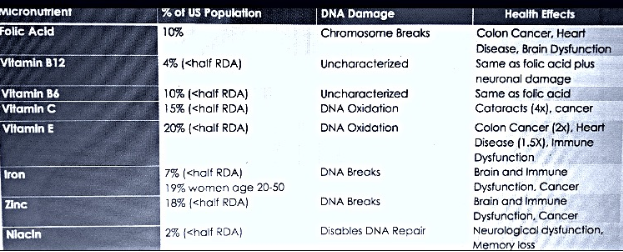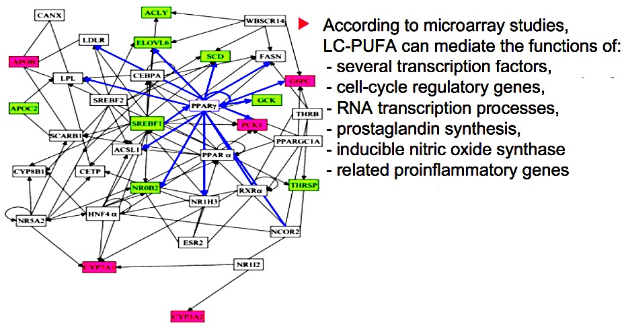Macronutrients, micronutrients and regulation of gene expression
In gene expression, a gene is used to synthesize a product such as a protein, rRNA, or even tRNA. If a cell is able to digest the nutrients from food such as a piece of cheese, you can figure out what gene is responsible for the digestion of this piece of cheese. In order to figure this out, what we can do is get an idea of what gene it may be and then just knock-out that gene. If we knock out the gene that plays an effect on the digestion of cheese, and then we eat cheese and we have a hard time digesting it, then we know that that certain gene played a role on its digestion (We can call this the knock-out process; we are knocking out a gene and then trying to figure out the true function of that gene, and this can work in other macro/micronutrients as well and that can help us study its effects). In reverse genetics you start with a gene and then you figure out what is the sequence of that gene. Afterwards you can look for other gene sequences somewhere else in the genome that share an equal sequence. Sequence it and then look for a homologous sequence somewhere else in the genome. If you know what that homologous sequence does, then odds are your accuracy is going to be more precise when it comes to finding out what that gene can express. If there is a homologous sequence, somewhere else in the genome and it goes for a specific protein and you are aware of the function of that protein, then it is most likely that the gene of interest has the ability to create a protein that has a similar function. Nutrigenetics aims to comprehend how your genetic makeup coordinates your response to a certain diet whereas Nutrigenomics studies how naturally occurring chemicals in the foods we consume alter molecular expression of genetic information within us individually. This leads to the production (even miss-production or no production at all if you are lacking a certain micro/macro nutrient vitamin or mineral) of different proteins in the body. There is a lot of different ways that a gene being activated or expressed vs inhibited or turned off can change the way your body functions. Our genetics alone do not determine our future health. In reality it is the interaction between genes and our environment. Genes are unique proteins that perform specialized functions in the cell. Our human genome has been identified to contain thousands upon thousands of different genes. There can be different levels of interaction between nutrition and genes. Nutrients that interact with a receptor may behave as transcription factors that can bind to DNA and acutely induce gene expression with or without the input of your body. This can lead to over expression of certain proteins that you may or necessarily not want. In Epigenetic interactions, nutrients have the ability to alter the structure of DNA so that gene expression is chronologically altered (this epigenetic change has the potential to be passed on to their offspring who’s never had that exposure). Common genetic variations such as SNPs (Single-nucleotide polymorphisms) can alter the expression or functionality of your genes. Nutrients such as folate, Vitamin B12, and even methionine have the potential to affect DNA transcription which affects the turning on and off of genes.
It is also important to discuss about selenium (Brazilian Nuts are my favorite when it comes to acquiring this nutrient); Not having enough selenium in the diet can affect DNA repair, adhesion and invasion (the ability of a cancer cell to stick on and set a base/framework as it spreads through the tissues). It can also affect signal transduction meaning it can take an impact on the signals being sent from the genes the proteins. It also acts as a tumor suppressor so selenium can fight against us acquiring a tumor. It can affect protein synthesis, growth factors, the cell cycle in apoptosis, angiogenesis (growth of new blood vessels. For a cancer cell to grow it needs a vast amount of nutrients ergo a higher blood supply to support that tumorous growth. One simple mineral not just selenium nut many others can affect so many different aspects of one of the most notable disease such as cancer. Polyunsaturated fatty acids known as your EPA and your DHA can affect your growth, neurological development, lean body mass, fat mass, reproduction, immunity, infectious pathologies of viruses, bacteria and parasites as well as several chronic and degenerative diseases.
The giant web in the graph above shows us the different ways that the long-chain polyunsaturated fatty acids can affect different genes in the body. These genes connect to a low microscopic level, that being the connection to the nucleus of our cells. The green are indicative of a down regulation while the red portray an up regulation. The clear portrays no regulation for a given gene in the picture above. It is notable that both sides up regulate and down regulate depending on the gene that it is impacting.
Peer reviewed article:
Sikalidis, A K. "From Food for Survival to Food for Personalized Optimal Health: A Historical Perspective of How Food and Nutrition Gave Rise to Nutrigenomics." Journal of the American College of Nutrition. U.S. National Library of Medicine, n.d. Web. 15 Oct. 2018.
Additional information for this topic was found in https://www.genome.gov/


Congratulations @wallyycc! You received a personal award!
Click here to view your Board
Congratulations @wallyycc! You received a personal award!
You can view your badges on your Steem Board and compare to others on the Steem Ranking
Vote for @Steemitboard as a witness to get one more award and increased upvotes!